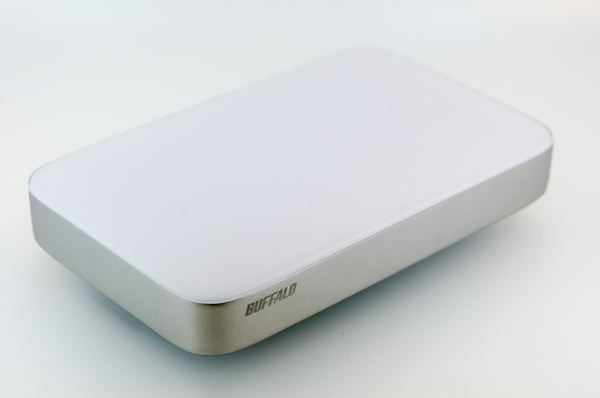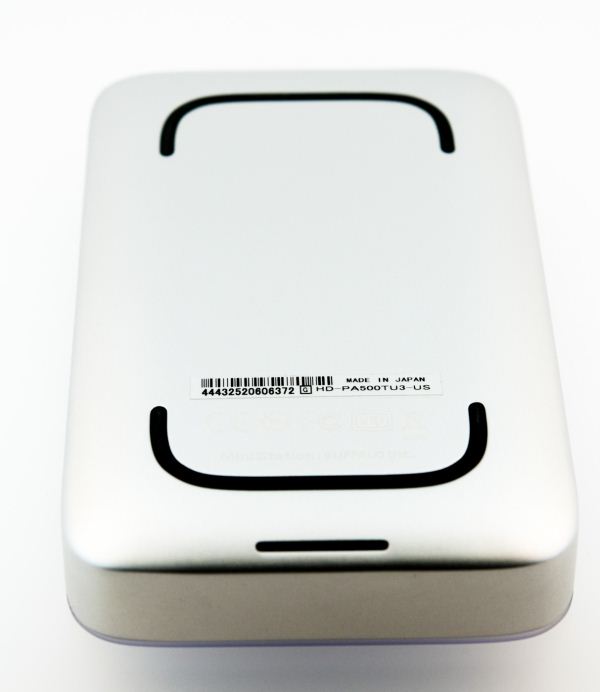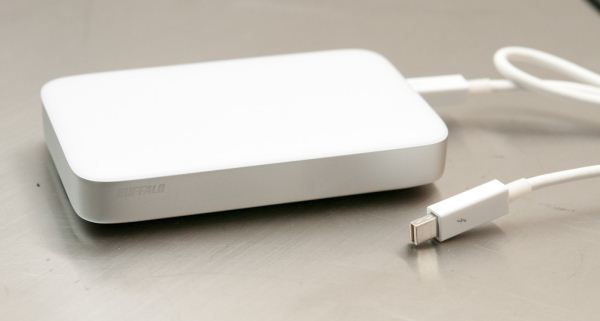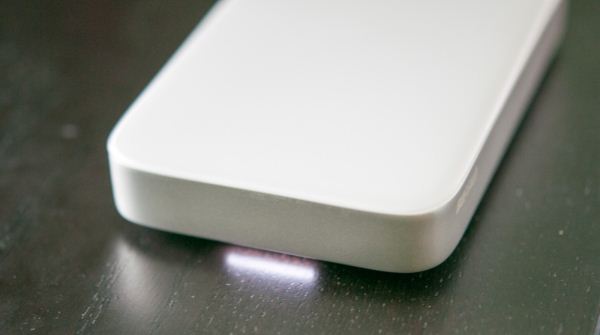Buffalo MiniStation Thunderbolt Review - An External with USB 3.0 and Thunderbolt
by Brian Klug on August 1, 2012 4:04 PM EST- Posted in
- Storage
- SSDs
- USB 3.0
- Thunderbolt
- Buffalo
Back when Thunderbolt (then Intel Lightpeak) was optical, I was actively involved in covering the interface, partly out of professional curiosity due to my optical background, partly because I sincerely believe optical interfaces are an inevitable part of the future. When Lightpeak became Thunderbolt and lost the optical layer, it fell under Anand’s beat and the Mac umbrella. I acquired a MacBook Pro with Thunderbolt somewhere around the same time, but never acquired any Thunderbolt peripherals or drives. Since then, Thunderbolt has slowly but surely gained traction with more and more peripherals and host devices. Initial adoption was glacial in part because most of the earliest Thunderbolt peripherals were really aimed at the very high end market with big RAID or JBOD stations, and partly due to what boiled down to Thunderbolt being Apple-only until just recently.
There’s an interesting story as to exactly why most of the initial Thunderbolt peripherals were aimed at such a high-end market, and some of it was purely because of both the TDP, size, and engineering constraints involved with the first generation Thunderbolt controllers. The other half of the equation is that selling external storage isn’t always the most valuable prospect, as shoppers expect commodity pricing and generally know the cost of the drive inside. Thankfully, second generation Thunderbolt controllers with smaller size, TDP, and lower cost are now the norm, and at the same time Apple has unleashed more Macs with the interface of note, meaning that there’s a bigger captive market of potentially interested shoppers.
So when Buffalo dropped us a line about an upcoming 2.5" form factor portable hard drive with both USB 3.0 and Thunderbolt interfaces, I couldn’t resist the temptation and jumped at the opportunity to review it. When it comes to single drive external Thunderbolt storage, the only real options at this point are either the Seagate GoFlex, or the new Buffalo MiniStation Thunderbolt.
The Buffalo MiniStation comes in two flavors, differentiated only in storage size. There’s a 1 TB version which runs $229.99 named the HD-PA1.0TU3, and a 500 GB version named the HD-PA500TU3 and priced at $199.99. The only difference is what drive you get inside; both include Thunderbolt and USB 3.0. Buffalo has also opted to include both the USB 3.0 and Thunderbolt cables with both MiniStations. Prior drives required the separate purchase of a Thunderbolt cable, which costs around $50. Since there are now multiple cable suppliers (whether this means the active controller in the cable, or companies cabling the system remains unknown to me), pricing has started creeping down and Buffalo was able to include both a 19.7 inch Thunderbolt cable and USB 3.0 cable.
| Buffalo MiniStation Thunderbolt | |||||
| HD-PA500TU3 | HD-PA1.0TU3 | ||||
| Storage | 500 GB HDD | 1 TB HDD | |||
| Interface | miniUSB 3.0 (2.0 legacy), Thunderbolt (no pass through), Cables Included | ||||
| Formatting | Mac (HFS+) | ||||
| Size, Mass | 3.17 x 5.12 x 0.91 (inches), 9.28 oz | ||||
| Pricing | $199.99 (newegg) | $229.99 (newegg) | |||
Since Thunderbolt is still predominantly an Apple interface (7-series boards and IVB Ultrabooks notwithstanding), the industrial design of the Buffalo MiniStation is decidedly Apple inspired. The drive is made of two main parts, a single piece aluminum can in which the drive sits, and a plastic top which snaps inside this assembly.
There’s a series of white status LEDs which shine through a diffuse rectangular chicklet cutout on the bottom front lip, which reflects up off of a surface. The indicator light breathes like an Apple power indicator when there’s activity, and stays solid when plugged in. It’s a nice take on an external hard disk status LED that I haven’t seen done before.
On the underside are two small rubber feet which actually aren’t part of the aluminum base but make contact with the drive caddy inside. Regulatory markings are laser etched near the front rubber foot. At the back of course are the Thunderbolt and USB 3.0 ports, on opposite sides of the drive.
Construction of the MiniStation is subjectively great. There’s not much flex if you squeeze the aluminum side against the plastic lip, and it feels like a solid brick of aluminum in the hand. I’ve regularly transferred videos shot on my DSLR onto the MiniStation, then tossed the drive into the main pocket of my backpack. It isn’t a super rugged design, but definitely will get the job done.





















61 Comments
View All Comments
scubaboy - Friday, November 30, 2012 - link
No, because all of Apple's current lineup of machines, with the exception of the Mac Pro, have multiple (either 2 or 4) USB3 ports. In addition to 1 or 2 TB ports.http://www.apple.com/why-mac/compare/
Lonyo - Thursday, August 2, 2012 - link
It's not a loaded question.The drive has no passthrough, therefore you are ONLY able to connect a single harddrive.
It's irrelevant what Thunderbolt can potentially do as a port, the port itself becomes totally irrelevant once you close it off by connecting this drive.
It doesn't matter if the port can do display connections, or anything else. Once you connect this particular drive, it can't, it can just access this drive.
Which is exactly the same as a USB drive would be.
Yes, Thunderbolt has other uses, but none of them are relevant when you use a drive without passthrough. Unless you are connecting it to the other end of a Thunderbolt device which DOES have passthrough, you are simply using Thunderbolt in the exact same way you would use a USB3 port, meaning any port advantage whatsoever is nonexistent.
Which is also why I said "With THIS drive", meaning this specific drive, not Thunderbolt drives or devices in general.
And I said "this drive" more than once, to try and make it clear I meant THIS drive.
repoman27 - Thursday, August 2, 2012 - link
Well, you could put this drive at the end of a chain of other Thunderbolt devices. It doesn't so much limit the port as it does the chain.MobiusStrip - Thursday, August 2, 2012 - link
The lack of passthrough is moronic. Talk about missing one of the points of Thunderbolt.sridhar.uta - Friday, August 17, 2012 - link
Of course you can see actual advantages of thunderbolt over usb3.0 only when you get into SSDs. Given the rate at which SSD prices are coming down, thunderbolt is definitely going to make a difference compared to usb3.0.But if all you want to do is stick a single HDD, then you are right you wont see any difference using a thunderbolt or usb3.0. Other than the only added advantage of daisy chaining in thunderbolt.
But I would it is not a proper comparision. I mean usb3.0 was out since 3 years or atleast 2 years isnt it. It is now it is now that the usb3 devices have become reasonably affordable. Thunderbolt has hardly hit an year with much more advantages and speed. So it will take time for it to sink and it definitely will.
Consider it this way, no matter what disk you stick in it is upto you. Lets take a usb3.0 enclosure which according to you is $30. Right now the cheapest thunderbolt seagate goflex portable adapter is $99. Add the cost of thunderbolt cable $50. So, with that extra difference you are way above the speeds of usb3 and even if you use a 60gb or 120 gb SSD which you can get for below or at $100 you are ahead of the curve provided you have the need. Add the daisy chaining advantage to it.
So an extra premium of $120 only within a year of thunderbolts adoption. Within next 6-12 months you are gonna see more difference.
Jaybus - Thursday, August 2, 2012 - link
The answer is obvious. You cannot compare an Intel QuickBench score to a Crystal Disk Mark score. There is not even a baseline of the Windows 7 NTFS over SATA6 to compare to USB 3.Both interfaces are so much faster than the drive itself that neither should have a performance advantage. The advantage for TB is that it works with MB Pros that do not have a USB 3.0 port. The advantage for USB 3.0 is that it is cheaper, and where TB's future is still not 100%, USB 3 will certainly be ubiquitous.
ggathagan - Thursday, August 2, 2012 - link
We agree.The last part of my comment was somewhat tongue-in-cheek.
Maybe I should have stated it as "There's an obvious advantage if you own a Mac, since none of them have USB3."
name99 - Thursday, August 2, 2012 - link
"There's an obvious advantage if you own a Mac, since none of them have USB3."Where by "none" you mean "every mac with Ivy Bridge", which means all the portables and probably within a month or so iMacs and Mac Minis, with only Mac Pro lagging?
philipma1957 - Thursday, August 2, 2012 - link
to PRPechek so why put a slow drive in it?Like I posted I purchased a lacie little big disk and put two ssds inside it I get 400 plus read and 350 plus write.
Why do I need this with a 5400 rpm slow motion hdd? It makes 0 sense to me.
Lonyo - Wednesday, August 1, 2012 - link
Am I missing something?$200 for a 500GB external HDD is not an "affordable price point" in my mind.
The only thing it has is Thunderbolt, which doesn't provide a real benefit when it doesn't have passthrough (so AFAIK, if you plug this in, nothing else can be used).
You can buy a USB3 1TB 2.5" drive for under $100 on Newegg. Less than half the price of this.
The only thing you lose is Thunderbolt, but as your testing shows, the mechanical drive is the same speed over Thunderbolt or USB3, so there's no loss.
The only way you lose out is if you want to throw in an SSD, in which case the entire concept isn't affordable anyway, due to the price of the SSD on top of the enclosure.
Assuming that people do switch to externals for storage for music and video, you don't need a flash external, meaning USB3 provides more than enough speed, and assuming you buy a sensible computer, you will have more ports available anyway (and leave any Thunderbolt ports free for other stuff).
I don't understand how your conclusion can possibly be reached based on what is presented in the article. It makes zero sense. Maybe for a Thunderbolt device it's a good deal, but as a Thunderbolt device it doesn't even make sense, so there's no reason to buy it in the first place as a Thunderbolt device, thereby leaving it to compete with far cheaper USB3 devices.